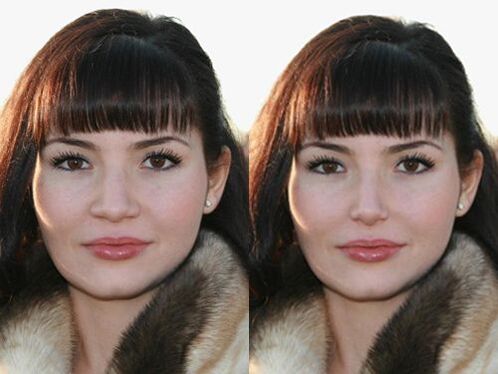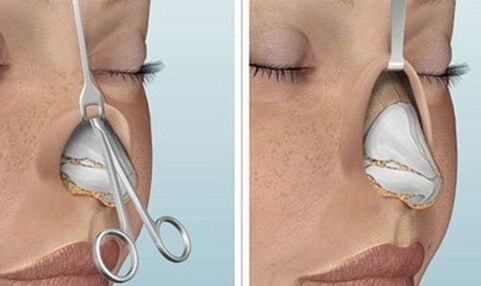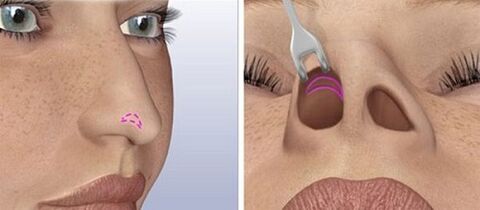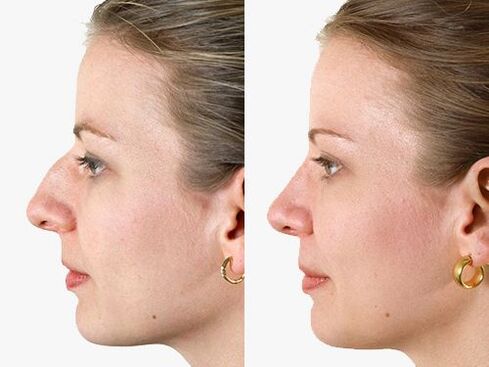
What is rhinoplasty or rhinoplasty?
It is one of the most common and ancient (first performed in 1000 BC) plastic surgery.
It represents a complete stage of reconstructive surgery that combines methods of surgically correcting the shape and size of the nose by replacing congenital or acquired defects in that part of the face with bone and cartilage tissue taken from the patient.
Rhinoplasty reshapes the patient and is one of the most effective ways to change the appearance.
Types and indications
The nose is a fragrance organ with a very complex anatomical structure. Surgical correction of this part of the body is considered one of the most difficult plastic surgeries in the world because the doctor must not only change its appearance but also maintain its functionality (in some cases, such a procedure leads to curvature of the osteochondral septum (causing difficulty breathing or odor). Therefore, before performing surgeries, their clients are advised to carefully consider and answer the question of whether or not it is worth performing a rhinoplasty (the exception is when the irregular shape of the nose causes breathing problems and oxygen can cause hunger in the brain). ) . The optimal age is 20-30 years, but it is done earlier in case of breathing problems or after serious injuries.
Main indications:
- disproportionate size of the respiratory system relative to the entire face;
- turbine hypertrophy;
- lesions or deformities in the bone or cartilage tissue in the area of the osteochondral septum, its curvature;
- asymmetrical, forked or too high tip of nose;
- "Hump";
- shortness of breath or difficulty;
- dissatisfaction with the results of previous plastics.
There are several types of rhinoplasty, which are classified according to the purpose and technique of the procedure:
- nasal apex plastic - surgical correction of the shape of the nasal tip or the elimination of asymmetry (bifurcation);
- vaccination (autotransplantation) - during the procedure, the doctor enlarges and, if necessary, lengthens the nose that is too small by transplanting cartilage tissue taken from the auricular area;
- reduction - a method of surgery aimed at correcting the shape and size of turbines;
- alignment of the back - removal of the hump at the back of the nose;
- septoplasty - a surgical method for the correction of a different nasal septum;
- augmentation - a surgical method to correct the shape of the nasal saddle to eliminate the effect of "flattening";
- non-surgical rhinoplasty - non-surgical correction of the shape, size and proportionality of the nose by injecting fillers (nasal contouring), the use of hormonal resorbable drugs that destroy the bone cartilage of the nasal septum, or the lifting of Aptos fibers (wings and the tip of the nose).
How is the operation prepared?
Before the procedure, the patient must visit a plastic surgeon who will measure the respiratory system, determine the amount of work to be done, use a special program to simulate the expected outcome of the operation on the computer (computer modeling helps the doctor better understand the client's wishes), and write a reference for the following tests:
- general and clinical blood tests;
- electrocardiogram (with decoding);
- fluorography;
- analysis for AIDS, HIV or hepatitis;
- tomography of the paranasal sinuses.
You must stop smoking and stop taking blood-thinning medications two weeks before the procedure. No food or drink is allowed 12 hours before surgery (light dinner is allowed the night before).
Before the procedure, doctors recommend good rest and sleep (this will help calm the nervous system).
Technique depending on the method
Immediately prior to the procedure, the client signs an agreement with the plastic surgery clinic that includes consent to the surgery, the cost and type of procedure, the name and surname of the anesthesiologist and plastic surgeon, and information that the patient is aware of postoperative complications andmethods. treatment. The person is then taken to the operating room, the face is cleansed with body lotion, the piercing is removed (if any) and, if necessary, the pre-operative marking is performed with a special marker. Surgery is performed under general intravenous or endotracheal anesthesia and lasts for 1-2 hours.
There are two ways to perform rhinoplasty: open and closed.
Open rhinoplasty
Open rhinoplasty is a procedure in which a doctor makes an incision in the columella (the part of the skin between the nostrils), corrects the shape of the nasal structures, and finally puts several cosmetic stitches on the skin. This surgical procedure is used to repair severe injuries and deformities of the nasal cavity and to reconstruct bone and cartilage tissue using an autograph.

Closed rhinoplasty
Closed rhinoplasty is a procedure in which a surgeon performs an incision inside the nasal cavity, separates the soft tissues from the osteochondral frame, performs a series of surgical procedures to change the shape of the nose, and then sutures the mucosa with a self-absorbing suture. It is a less traumatic method of plastic surgery, after which complications are rare and scars remain.

After an unsuccessful first surgery, or a result that does not match the client, doctors perform a second (secondary) rhinoplasty. This is a more complex (technically) procedure that requires certain skills and practical experience from the surgeon, is performed under general anesthesia, and requires the same preparation as the primary plastic. At the earliest one year after the previous surgery.
Recovery period and results
The rehabilitation period lasts 3-4 weeks, but the patient spends a day in the hospital. Immediately after surgery, a swab is placed in each nostril, which is removed by the surgeon after three days, and a plaster bandage is applied to the nose (removed after ten days). After removing the tampon, the doctor prescribes drops to the patient to eliminate postoperative edema and speed up the healing of soft tissues. Swelling and bruising disappear completely after 1, 5-2 months. The preliminary result is evaluated after 6-8 months, the final result - after 12. Scars after rhinoplasty are visible for the first three months and then become almost invisible.
Postoperative recommendations:
- you should sleep on your back two weeks after the surgical correction;
- during the first weeks you may not visit the sauna, swimming pool, solarium, gym or do any strenuous physical work;
- you can only eat hot food and drink hot drinks until the wounds have healed completely after the operation;
- You should not wear glasses for 2-3 months after the procedure;
- do not smoke during the entire recovery period.
Results of rhinoplasty or rhinoplasty: before and after images


Possible complications and contraindications
Contraindications:
- oncology;
- runny nose;
- influenza, SARS;
- active herpes;
- diabetes;
- atrophic rhinitis;
- infectious diseases of the oral cavity;
- mental disorders;
- tuberculosis;
- heart and kidney disorders.
Rhinoplasty is called one of the most difficult plastic surgeries in the world, in which the surgeon often removes not one but several cosmetic defects at once, so it leads to a number of possible complications:
- nose bleeding;
- postoperative pigmentation;
- swelling and hematoma of soft tissues;
- odor loss;
- the appearance of keloid scars;
- difficulty breathing;
- curvature of the nasal septum.
What operations can be combined?
Rhinoplasty is most often combined with septoplasty - surgical correction of the nasal septum (sometimes called septinhinoplasty), cheiloplasty (to change the shape and volume of the lips) and mammoplasty - the purpose of which is plastic surgery. breast (in the latter case, two doctors are present at the surgery, one performing rhinoplasty and the other breast surgery).
Estimated cost of rhinoplasty (nose job)
The plastic surgeon will provide accurate information on how much a nose surgery will cost. The cost of rhinoplasty includes prior consultation, hospital stay, computer simulation of results, removal of tampons, and removal of the dressing. The cost of the procedure depends on the type and method of surgery.
Rhinoplasty is a popular operation among both women and men. It helps people get rid of health problems, improve facial appearance and proportions.






















